Clandestine Blaze|Nicole 12
2022-09-21
by Niklas Göransson
Finnish counterculture artist Mikko Aspa discusses Secrets of Laceration – the latest Clandestine Blaze album – and explains the concepts behind his notorious power electronics project Nicole 12.
– None of the material on “Secrets of Laceration” is old; I rejected all leftovers from the previous albums. I composed the riffs towards the end of 2019 and then arranged and recorded the songs in early 2020. Vocals were tracked later in the same year. The original intention was to make the shortest and most aggressive CLANDESTINE BLAZE record to date, but it came out slower and more mid-paced than much of my past work. I envisioned a core consisting of unpleasantly buzzing distorted guitars – but framed in a somewhat ‘studio recording’-sounding production. As for my influences, they remain the same timeless black metal cult albums that are as vital today as they were all those years ago.
I remember reading an old forum post, probably around “Falling Monuments” in 2010, stating something to the effect of, ‘CLANDESTINE BLAZE is not a black metal band, it’s power electronics disguised as metal.’ The author seemingly meant this as criticism, yet I found it rather poignant.
– There is certainly some validity to this claim. I’ve stated in many old interviews that CB intends to reject most things ‘metal’. At the time, it wasn’t very common to have a policy of anonymity – or making neither band photos nor even basic info available. The sound on these releases, as well as the way they were published, had very little in common with metal; at least as it was back then. Same thing with many of my major influences, such as BEHERIT and BURZUM, who were clearly aided by elements drawn from electronic music in their creation of the most pitch-black of metal. This wouldn’t have happened if they had approached their art merely from the metal tradition. Do you remember how some guys got annoyed upon discovering that the main riff from BEHERIT’s “Gate of Nanna” was influenced by 2 UNLIMITED? Speed up the tempo and play it with lead synth and you have techno club material! Nevertheless, it is undoubtedly one of the darkest and most iconic riffs in Finnish black metal history.
After the classic “Drawing Down the Moon” in 1993, BEHERIT mastermind Nuclear Holocausto Vengeance shocked a lot of fans when he began talking about rave music in interviews. To even greater surprise was “H418ov21.C” – the ambient BEHERIT album that came out the following year.
– BURZUM’s non-metal sources of inspiration are clearly evident in most of his work, regardless of instrumentation. CLANDESTINE BLAZE in its original form would not have been the same without power electronics or industrial music. Even if CB barely ever experimented with electronics, it was approached with monotony, minimalism, and a dark and rusty atmosphere achieved with traditional metal instruments. On the other hand, ever since the fifth album… well, while by no means uplifting heavy metal, there might be more musical merit involved than the crude mechanical repetition of the early days.
Not only was the late-90s and 00s CLANDESTINE BLAZE much harsher, but also far less rhythmically immersive. Mikko seems to have become less inclined towards musical monotony in general – a tendency which can also be seen in his power electronics project GRUNT. The term might sound odd in a CB context, but there wasn’t much ‘groove’ to Mikko’s percussion during the early days.
– Some of my favourite drummers have groove: the second DARKTHRONE album, AUTOPSY in general, Capricornus-era GRAVELAND, BURZUM’s debut, etcetera. Even if ‘groove’ might sound like an obscene choice of word, I’m sure people know what I mean. Having a feel, rather than a technical approach. This change in the CB drumming was a conscious choice. When a follow-up to “Secrets of Laceration” comes, that’s the area where most changes are likely to appear. As I said before, the original intent of CLANDESTINE BLAZE was to reject all notions of ‘musicianship’ or deriving joy from playing. Already twenty years ago I had been in several bands that required different types of drumming. To pursue minimalism in CB was a decision I made for the sake of achieving certain desired results. Intentions have shifted a bit over the years; it has nothing to do with showing off skills, but all percussion needs to complement the riffs and the general atmosphere of my art.
The last three albums in particular contain a number of real rippers that almost beg to be performed in concert. Using a session line-up, CLANDESTINE BLAZE performed live a few times in 2015 and 2016. Now that stage entertainment is an option again, perhaps we will see Mikko hitting the festival circuit.
– I’ve never been deeply involved with the black metal festival scene, and I don’t really care much for the notion of bands existing for the sole purpose of playing open-air fests. But I do have respect for those who tour in full accordance with their own code of honour. This subject can be approached from many angles – one being that black metal, as a superior form of music, is certainly no lesser than your average popular metal acts. Some black metal bands can play in broad daylight, on a big stage, and make metal veterans look lazy and lame. But this requires qualities not possessed by everyone. Most of them simply couldn’t pull it off without looking ridiculous. Should CB return to live activity, I won’t even consider any offers beyond the level of Steelfest, which is the best festival I’m currently aware of. I’d prefer small, closed networks completely cut off from the music industry.
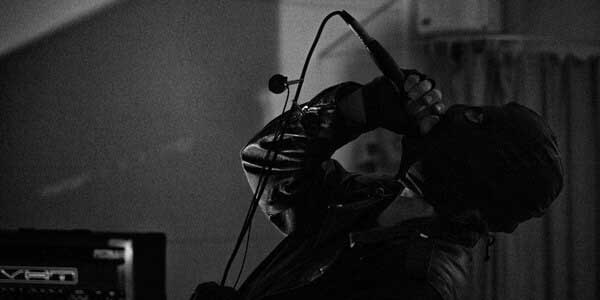
In a previous conversation, Mikko told me he believes his music to contain a spirit of its own – one that’s capable of dictating the nature of its narration.
– I record the material and then listen to it repeatedly, relying on my gut feeling to sense what sentiments the music expresses. Each individual part has a specific aura, as do songs as a whole. For a violent or melancholic piece, there are perfectly suitable themes to be found in the sound itself. For music that’s more epic – or dissonant, with bizarre melody patterns – specific themes feel far more appropriate than just using ‘whatever’. This is a diametrically opposite methodology from my earlier works. Oftentimes, the lyrics were written first; the music then followed the words, or they would simply be fused together without any obvious connection. That is, of course, perfectly fine. Especially if there is an ideological slant to the project, rather than just music meant to work by itself.
The album closer, which is also its title track, is an adaptation of sorts from The Temptation to Exist – a collection of essays by Romanian philosopher Emil Cioran.
– This is another method I’ve used in the past: using lyrical content that is not my own, but pre-existing text re-framed in a CLANDESTINE BLAZE context. Sometimes it might reveal itself through unexpectedly advanced language skills. See for example “City of Slaughter” where the concept of stolen texts was a crucial component of the actual theme. The album’s true message may be buried under a rough-edged surface.
In one of the paragraphs used, Cioran speaks of ‘siding with our dangers’; meaning, as far as I understand, intentionally looking for trouble. I wouldn’t be at all surprised if some people have this impression of Mikko.
– Perhaps a more accurate interpretation would be ‘not actively avoiding the possibility of danger’. To not run away from who and what you are. I don’t really seek out trouble, but I will certainly not adjust my life for the sake of escaping it. Now, many will say that this attitude brings unwanted attention… that it destroys ‘careers’, business opportunities, human relationships, and whatnot. I can only conclude: so what? I realise that some people simply want to be left alone, to live and create in the shadows without any adversarial interactions or unnecessary distractions. That’s fine. However, when it’s done for fear of being rejected by contemporary music genres or society itself… that’s where my sympathy levels drop – significantly. To me, this is an abomination. I’ve always regarded both black metal and industrial noise as forces firmly rooted in the counterculture. In this field, you don’t necessarily have to ‘look for trouble’; more than likely, it will come looking for you.
It’s been said that Mikko is the type of individual who can approach the vilest atrocities in a cold and calculating manner. With composure, without losing his shit, and neither condoning nor condemning. If I have interpreted him correctly, this mindset – along with his penchant for offensive or outright disturbing artistic output – is connected to notions about the Übermensch.
– Ideally, yes – absolutely! Of course, one may still be bound into restraints of mundane human emotions, and I know plenty of people who wish to keep them. Sacred boundaries, so to speak. However, in the transition from nihilism to re-evaluation and the creation of new values, I do not see much that should be left untouched by the hammer. To me, it’s been a lifelong amazement to witness the entire world struck by surprise and disbelief whenever fractures form in their understanding of human capabilities and urges. Be it something as trite as a terrorist attack; the crowd howls in outrage, saying that nothing could explain or justify such cowardly actions. Their leaders do the same. While the first feeling you get is: ‘Pff, yeah right…’
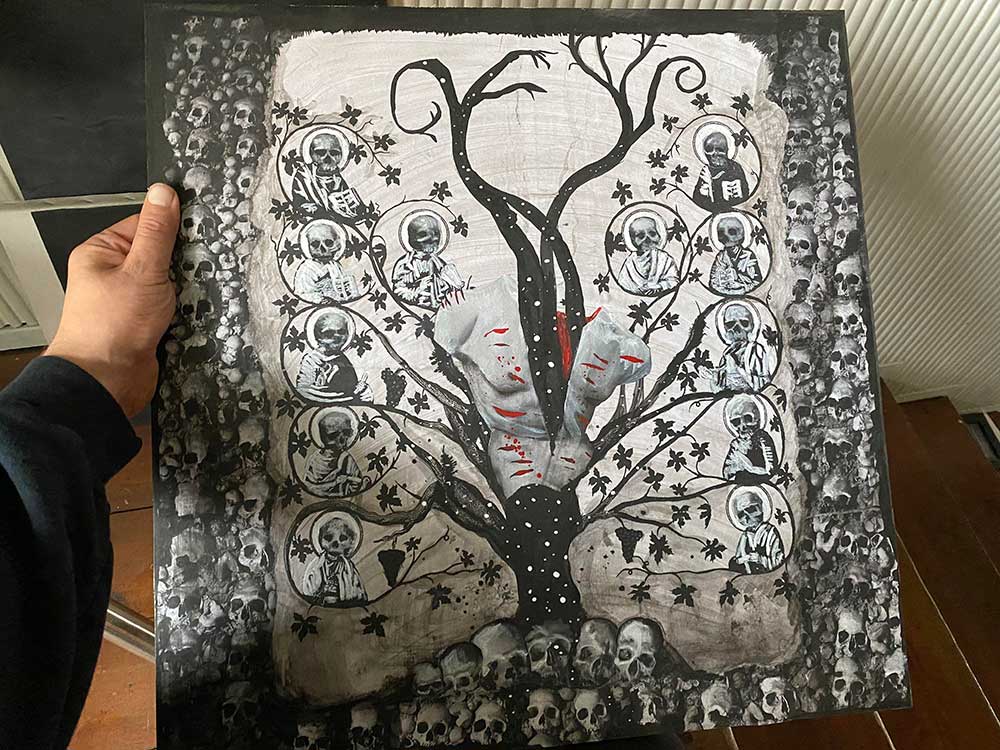
One of Mikko’s most controversial music projects – and that is with some seriously stiff competition – is called NICOLE 12. Originally a conceptual spin-off from GRUNT, it lasted from 1999 to 2011; a power electronics tale in three chapters, one could say, delving painfully deep into topics pertaining to the foulest of sexual predation.
– The overall theme was nothing new to the genre. From the very beginning, the founding artists of industrial music – like THROBBING GRISTLE with the vicious “Very Friendly” (1975), or early-80s WHITEHOUSE, SUTCLIFFE JUGEND, and so on – explored the utmost taboos. You had a level of coldness in titles of MAUTHAUSEN ORCHESTRA, BRIGHTER DEATH NOW, and such that would send shivers down the spine of anyone who’d prefer not to be reminded about abused or dying kids. For many bands, this is just one concept among many. This genre has always upheld strong traditions of looking at the world from a premise entirely devoid of empathy or moral concerns. To broach for discussion matters of which existence most people would simply prefer not to acknowledge. Topics they believe can only be portrayed through a lens of sentimental abhorrence.
The first NICOLE 12 album, “Playground”, was released in 2001. As was the case with all the project’s studio recordings, Mikko put it out through his industrial label and distro, Freak Animal.
– “Playground” established the overall sonic, stylistic, and thematic direction of NICOLE 12. The red thread in “Substitute” (2003) was observing the paradox of how substitutes for what is shunned and forbidden are always present and sold to the populace as commodities of mainstream culture. The third LP, “Black Line” from 2011, studied victimisation, art history, and the media. Smaller releases between albums had their own topics, always taking different viewpoints or scrutinising certain details. Each of them includes material meant to contribute to the overall atmosphere.
NICOLE 12 features a lot of harrowing samples, presumably from various news reports following the arrest of a predator. To my understanding, they are meant to emotionally impact the listening experience – not as provocations or endorsements of said activities.
– That’s beside the point. There are so many angles and nuances to each release. What may be true regarding some samples might not apply to others. For example, if one takes a look at the sheer brutality of “Candyman”, which was a collaboration between NICOLE 12 and notorious power electronics legend Taint, one could see vast differences compared to, say, “Black Line”. If someone demands an explanation as to whether any of it is ‘endorsement’… well, then I don’t think they quite ‘get it’. I guess it’s safe to say that people tend to describe NICOLE 12 – in a horrified fashion and with great indignation – as a project only about paedos and child abuse and that’s that. Straight from the beginning, it was acknowledged that the vulgarity of NICOLE 12 would make it nearly impossible to be seen as anything but the utmost provocation. Its conceptual structure serves as a foundation for something that expands way beyond and lingers there, regardless if people can see it or not.
Can you explain these concepts that apparently go over everyone’s heads then?
– A big part of the NICOLE 12 material was documenting reality, mostly in a historical style. This is very different from something like gore-grind or sleazy and morbid death metal fantasy tales. Most of N12 is basically investigative journalism. However, this project was never meant as ‘education’, nor does it carry a specific message. It does not lecture, provide guidelines for thought, or propose any solutions. What it offers is exactly the core idea of industrial music: topics deemed too reprehensible to even discuss are examined and dissected with pathologically detailed analysis. Methods of propaganda and media hypocrisy can be considered from this position. One can observe cultural shifts, religious morals, as well as a surprisingly thin line between what’s regarded as ‘normal’ and exploitative, antisocial behaviour. Most of the hidden, veiled structures can be interesting – history that’s been forbidden and tidied up… history that is basically erased, especially when it contains revelations which are unpleasant from the current perspective.
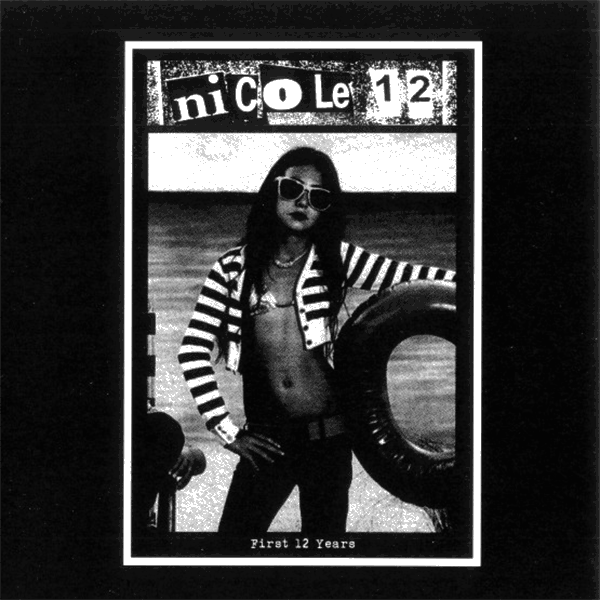
I’m curious what the album layouts look like; I myself didn’t quite get that far. First, I accidentally clicked the cover of “First 12 Years” – a NICOLE 12 compilation – while perusing Discogs and was seized by the sudden urge to delete my browsing history and clear the web cache.
– “First 12 Years” is probably the softest cover of them all! The photo is from a widely available fashion mag called Vogue Bambini. Well, now that magazine sales have declined over the years, it is perhaps not in every newsstand but mostly carried by outlets selling specialist lifestyle periodicals. Either way, it’s all professional, like Vogue itself. Why this is suitable for the N12 theme? While it contains just regular kids’ fashion, you can browse online to check out what other type of stuff it also includes, hah.
I think I’ll pass on that one. I then spotted the “Substitute” cover, which spelled the abrupt end to my investigation into the visual representation of NICOLE 12.
– Yes, that one is probably the most controversial. However, as suggested by the title, there is no underage person on the cover – but a ‘substitute’. The woman depicted was twenty-seven years old at the time. I used a Polaroid camera, and when the photo came out it blew my mind to see how much the lens optics had distorted her physique. The picture emerged entirely unplanned, but how and where it was to be used became clear instantly. I scratched out her face and finished the design, resulting in something that was not easy to get printed. There was nothing illegal about it, yet “Substitute” is the only release where I felt it necessary to include a little disclaimer… despite this being somewhat counterproductive for the album’s atmosphere. It would essentially be a good thing for the listeners to not only feel as if they are doing something wrong, but also get over it.
Is there anything even borderline illegal in any of the releases?
– I suppose this would depend on the legal situation of each country. While it’s fine in the context of art here in Finland – as well as in the EU and other parts of the civilised West – it can be a bit of a gamble with obscenity laws. I’ve had dealings with local law enforcement, and they determined that all NICOLE 12 items are ‘okay to sell’. None of it includes any sexual nudity or pornography.
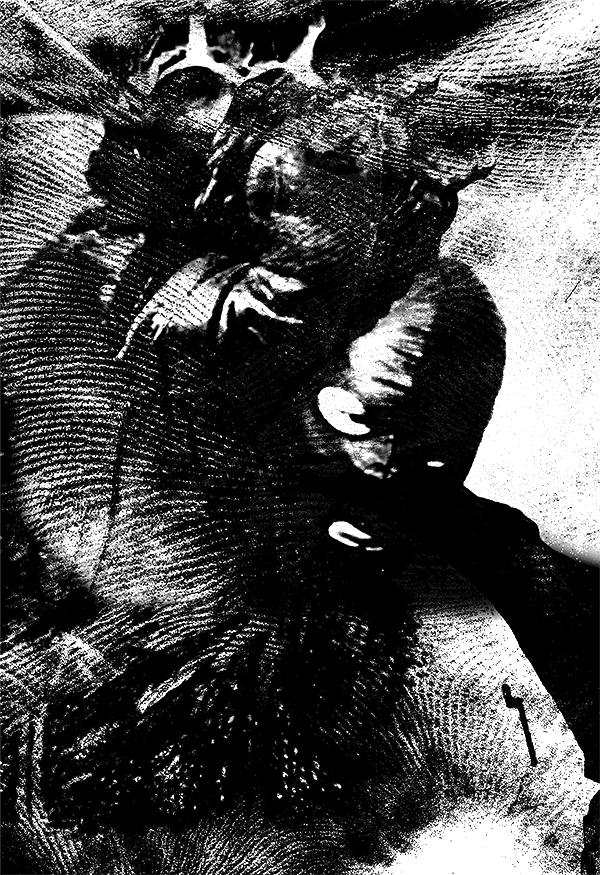
Can you elaborate on this substitute concept?
– With ‘substitutes’ I am referring to the things people often resort to when they can’t access the ‘real deal’, so to speak. For example, the most popular searches on the world’s largest porn sites are terms like ‘skinny petite teen anal’. Nowadays, top-of-site suggestions are always an endless stream of incest porn. For legal and ‘moral’ reasons, they specify ‘step-mother’, ‘step-daughter’, and so on. Here, the ‘step’ prefix clarifies the nature of substitutes. Most of the target audience would probably have no righteous objection to clicking videos depicting the real thing. All indications are that many porn surfers actively seek out the absolute youngest, most innocent and fragile target that can be legally consumed. A lot of the best-selling stuff from the era of VHS, DVD, and print magazines came from big companies doing stuff like ‘Barely Legal’. For decades, Seventeen has remained one of the longest living and successful European companies – despite the fact that they were always pretty damn crappy.
At its founding in 1975, Seventeen was an adult magazine with a focus on models aged sixteen and up. This was perfectly legal throughout most of Europe back in those days, and it proved to be a hugely popular formula. The only real problem the publication encountered was when they featured a German-Kurdish girl as a cover model; this angered the local Kurd diaspora to the extent that, following threats, Seventeen had to be pulled from circulation in all of Germany. They began producing similarly themed videos in 1983. Come the late 90s, following updated European legislation, Club Seventeen – as they had rebranded themselves – started featuring models of at least eighteen years of age.
– Still in the early 90s, there was a big European company – one of the leading corporations in the industry – putting out a magazine called Fifteen. The name refers to the legal age at the time: sixteen. So, Fifteen was a sort of hint towards the ‘forbidden fruit’. It became vastly popular. Back in the mid-80s, Danish companies would pride themselves in rejecting flat-out kiddy stuff and assure their readerships that all models were sixteen or older. So, plenty of vintage material is somewhat dubious from a modern legal perspective. It’s important to note how none of this emerged out of some reprehensible porn underground, but from the biggest and most widely distributed mainstream business side of adult entertainment. When the laws changed in countries like Denmark and Japan, some of the same companies quickly started putting out substitute material: books with stories and drawings instead of banned photography or videos. Like the highly lucrative anime business, where all things are fictional and therefore legal in Japan. Actually, wasn’t someone in Sweden taken to court for underage loli hentai?
In 2010, a Swedish translator specialised in the Japanese comic style known as manga was charged for being in possession of illustrations perceived to depict children in sexual situations. He was convicted for child pornography by the district court, a sentencing which was upheld in the court of appeal, but then found not guilty by the supreme court two years later.
– Fiction has been criminalised in some countries, but mainly for the visuals. When legislation changed, they were probably aware that in a few years one won’t really be able to tell whether an image is a digital illustration, a modification, or if it’s an authentic photo. Therefore, made-up images were proclaimed ‘illegal’. But it’s not as if people or companies draw the line by automation; clearly, these laws and the enforcement thereof are the only factors keeping things… ahem, ‘barely legal’! The popularity of all this displays a situation where a lot of consumers, as well as society in general, like to think of themselves as ‘drawing the line’… but doesn’t it appear more like desperate attempts to escape legal consequences than stances of ‘morality’? Another example: the vast majority of men’s magazines used to regularly run short stories about pre-teens engaging in sexual activities.
Are you serious?
– Oh yes. That was in pretty much all men’s magazines back in the day. It was only after the 90s that fictional stories started becoming somewhat restricted, so it was no longer in good taste to feature them in your publication. That’s when they moved online: mainly to an internet newsgroup system called Usenet. Compared to Seventeen and such, these things were totally underground. This was way, way before you could use computer technology to send out pictures or videos, so these groups were entirely text-based. They would often have ‘alt.’ in the beginning to indicate ‘alternative’. It’s quite brutal how much of it was utmost filth, featuring kid snuff fantasies side-by-side with soft-core erotica. Just insane amounts of… not so soft stuff. But this is perfectly fine in many countries: it’s the images, actual depictions of crimes so to speak, that are illegal. A novel has no clear victim per se. If you want to check it out, there are well-known websites which have collected all these stories.
I don’t imagine I’ll be delving too far into this – can you give me a summary?
– Some people decided to start collecting all the posts from Usenet groups into servers accessible via either FTP or a regular internet browser. I think they are still operating to this day, funded by donations. These sites are free and host literally hundreds of thousands of novels. All of them are coded based on their themes. For example, ‘MMF, NC, snuff’ means two adult men – MM – one adult woman, F, and then Non-Consensual concluding with murder. Again, all of this is just fantasy sex stories. Everything from fanfiction, sci-fi, lesbian erotica to the flat-out most sickening stories you’ll ever come across. But if you see a headline saying ‘MFF, scat, incest, beast, NC’, and so on, it’s up to you whether you want to read it. There have probably been countless sex-story sites, groups, and forums… and probably still are, but I’m not really interested in internet porn beyond the ‘phenomenon’.
Wouldn’t all this have moved to the darknet by now?
– I suppose so. I’ve never really understood that system at all, nor do I have any need to. But there are some curious aspects. For most of the time, I’m sure people on the regular internet were aware that what they post or search for can be traced. With the dark web, there was an era when you were told that it would be impossible to get caught there. If the risk is deemed non-existent, or at least minimal, one can only imagine the type of material in circulation. Still, these days the public internet has everything from beheadings to men undergoing self-castration.
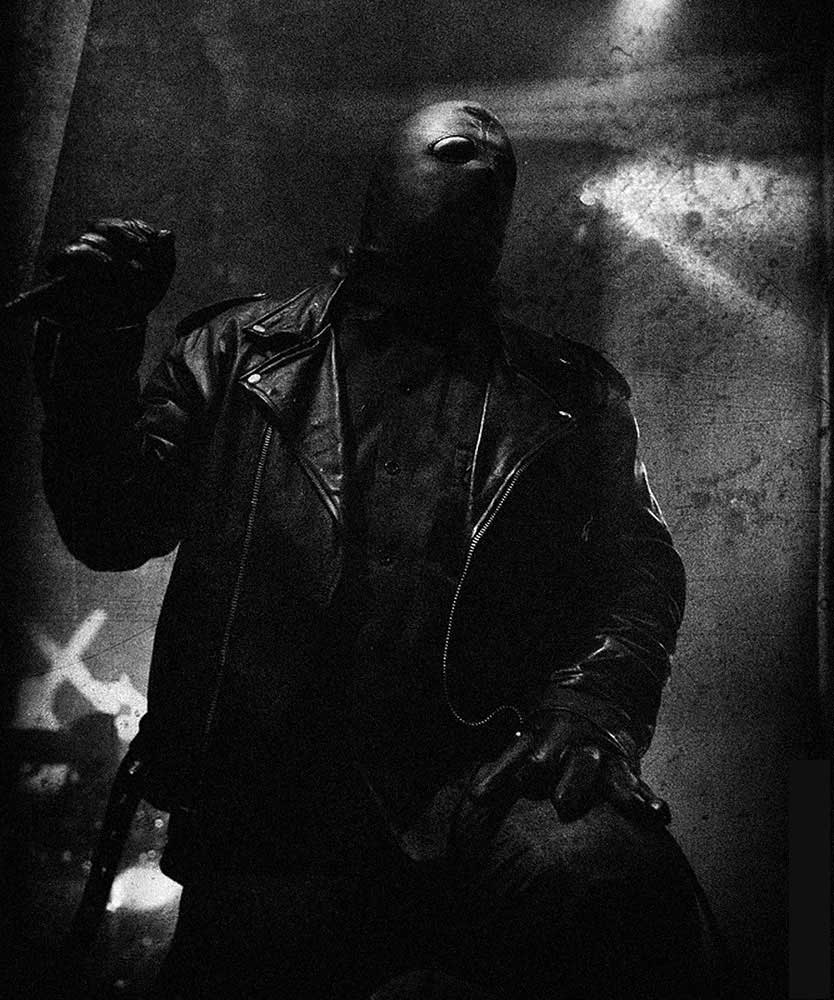
For a demonstration of the latter category, interested parties are advised to check out the ‘Pain Olympics’ entries.
– Recently, someone sent me a clip of an Asian case where some men cut out the heart of a victim and then laughed as it kept pumping for a while. There is an endless stream of brutal accidents, mutilations, death, and piles of corpses… and whilst I’m not really affected by this, it seems to me that having a cup of coffee while listening to some noise seven-inch is infinitely preferable to yet another execution clip I didn’t ask to see. But this is a sign of the times: society is obsessed with school uniforms, virginity, shaven cunts, and so on and on, and if one would really take a look, it could be challenging to see where ‘mainstream culture’ ends and pornography starts. Video footage of child beauty pageants, flirty kids beach fashion, and Max Hardcore films have almost outrageous similarities.
Max Hardcore is an American actor and director of pornographic films. In the early 90s, he garnered commercial success and critical acclaim for his series The Anal Adventures of Max Hardcore. He soon made a name for himself as the producer of some of the most extreme pornography available.
– Decade after decade his videos featured young models, dressed pretty much in pre-teen outfits, being mercilessly abused. These were often hard enough to be illegal in the USA unless edited, but the European industry welcomed uncut DVD editions – even after Max was imprisoned for them. Eighteen-plus models begging him to ‘Fuck her twelve-year-old ass’, hah. Adults pretending to be underage in porn is illegal in most countries, so he was definitely pushing the limits.
During the mid-2000s, the administration of George W Bush decided to take on the rapidly growing porn industry. A Department of Justice unit called the Obscenity Prosecution Task Force was created with the purpose of bringing down ‘manufacturers and purveyors’ of adult entertainment. In October 2005, the FBI raided the California offices of Max World Entertainment, Inc. and seized a number of video titles as well as the company servers. One of the agents accidentally discharged his firearm in the process, sending a bullet flying through the floor of the office upstairs. Two years later, Max Hardcore found himself indicted on obscenity charges for distributing pornography featuring fisting, pissing, and vomiting. He was sentenced to three and a half years in prison.
– I’m certainly a fan of Max Hardcore. Not that I watch much of it nowadays, but he was a visionary and a pioneer. Despite appearing like a sleazy old brute, he was always careful with legal contracts, health checks, etcetera. He was often said to be one of the most caring guys, with STD tests for himself and his models. He was one hundred percent professional, but also a transgressive provocateur – to the point of using the hard rock song “Shotgun Suicide” as background music for one scene on a DVD reissue where the model had subsequently committed suicide… by blowing her brains out. While most people in the industry usually appear clean from the surface but are abusive inside, Max might seem vile but is, in reality, both friendly and professional, hah! Along with other stuff, this nugget of information was included in the “Subsititute” booklet.
Controversy aside, NICOLE 12 has sold rather well – at least judging by the multiple reissues. There appears to be plenty of demand for the early LPs; alas, the lot of them are prohibited from sale on Discogs.
– As far as I know, NICOLE 12 was among the very first titles to be banned on Discogs. While all RAC, black metal, obscene gore-grind, and the most sadistic power electronics was just fine, N12 and a handful of other bands were flat-out banned. Of course, this is not surprising. With all pressings calculated together, I think these releases have sold somewhere in the range of five thousand copies. They were always among the best-sellers of Freak Animal, and year after year they remain re-stocked and sold out by distributors. Of course, these are small numbers compared to famous metal bands – but in the context of this genre, N12 has sold more than most.
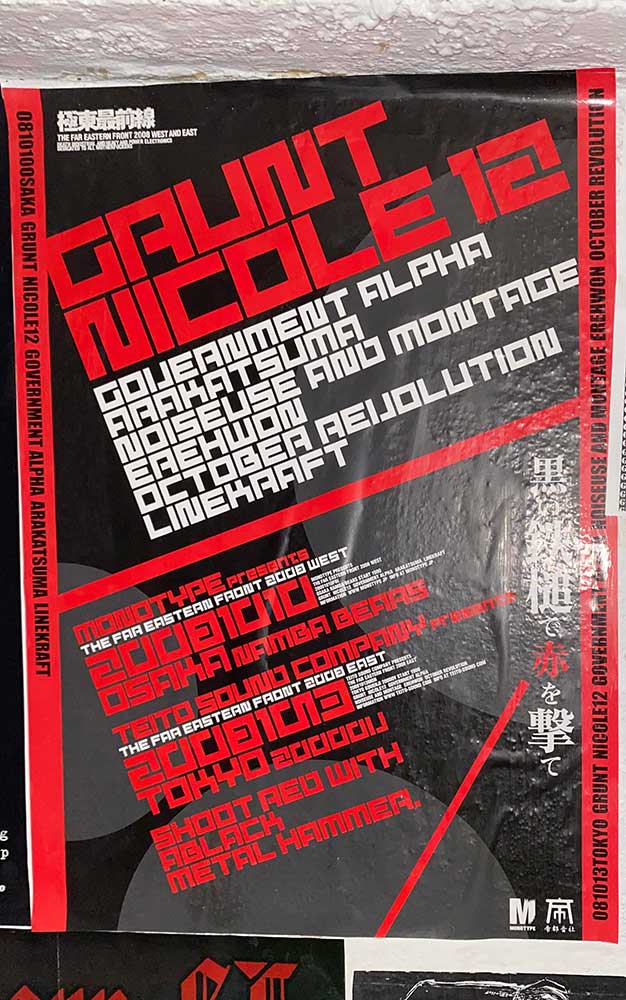
The project has performed in concert – in Japan, of all places. One can only imagine what this was like. I refrained from investigating the matter myself; ‘nicole 12 live’ is not a search term I want to have associated with my IP address.
– The show contained nothing highly explicit. The video projection included footage made of stills taken from various mainstream fashion magazines. I performed all dressed in white, including a mask. I received plenty of offers to play live – and still get them, despite having buried the project a decade ago – but there was never any serious intention to do more than these two gigs. In Japan, there was a specific point to be made. This wouldn’t have worked anywhere in the West, especially in the context of people coming to the gig to ‘have fun’ or to seek thrills.
As a connoisseur of adult entertainment – Mikko has both produced and written extensively about pornography – I’m wondering what he makes of the Japanese peculiarities. My friend visited Tokyo and entered some random video store that just happened to be broadcasting ‘tentacle porn’. Meaning, women with various tentacled creatures squirming around inside their genitals. I wouldn’t even have imagined that was an established subgenre.
– Japan has a market for every conceivable perversion. Be it women clad in spandex while rubbing themselves with balloons or people crawling around in the sewer eating maggots and vomit – rest assured they will have it. It’s not all that noteworthy that certain odd fetishes exist, but far more so how entire industries have been built around them. Perhaps not only industry, but even bigger cultural phenomena. It exists not only virtually, but in the form of events, dedicated clubs, shops, magazines, companies and so forth. It’s been observed that all cultures have dark undercurrents. It does not exist separately from the perceived ‘good side’ but as something which enables the existence of this good old ideology. It’s meant to present a clean façade which secretly fuels these deviancies. However, our current day offers perversions that hide the actual ideology.
It’s interesting to note how in modern times, both Germany and Japan – two once-proud military nations – have garnered reputations for serious sexual eccentricities.
– Core ideals such as nobility and beauty – ones which may have flourished in Germany and Japan – are largely regarded grotesque abominations in contemporary Western thinking. Athletic strength of the perfect man transformed into caricatures of medicalised bodybuilders. The vibrant vitality of youth transformed into kids doing drag-shows. Totalitarianism in favour of national interests transformed into a tyranny catering to multinational corporations, and so on and on. In the last example, perversion is an expression of the hedonistic freedom that hides the vicious ideology lurking beneath. This is precisely what’s reflected in some works of NICOLE 12. The current cultural climate exists on levels of corruption and perversion that can be observed in light of the aforementioned substitutes, as well as the methods described in the “Black Line” album. Of course, one doesn’t have to acknowledge this to get something out of the creations.
What is this “Black Line” concept?
– It is about the process of creating sexualised victims out of things that should be emanating beauty and vitality. The title came from a legal case concerning the world-renowned works of American photographer Sally Mann. In 1992, she released a photo book called Immediate Family: it features over sixty shots of her family, a few of which show her kids playing in the nude. The Wall Street Journal decided to feign outrage and carry out a witch-hunt; they took her large art photographs, zoomed in and cropped them into an image of only her naked daughter and then added black lines to censor her face and genitals. Suddenly, a formerly stylish naturist art picture appears on the front page of a newspaper, in modified and brutally re-contextualised form, as proof of ‘abuse’ and speaking of ‘sexual purposes’.
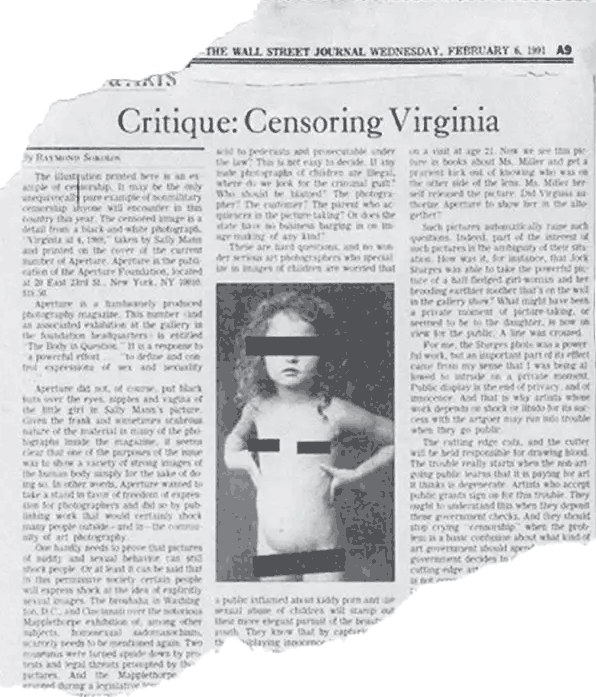
According to a documentary called Blood Ties: The Life and Work of Sally Mann, her daughter Virginia became upset when she saw the WSJ article. ‘What’s wrong with me?’ she asked, pointing to the areas of her body that were blacked out.
– It’s common to hype outrage and create victims in order to enforce bizarre moralism. When pornography and the media both, at the same time, twist the perception into pure perversion, it hints at levels of deviancy previously unseen. There are vast numbers of people who seem unable to cope with this. We see it in the news all the time. For example: last summer here in Finland, Audi ran a commercial with a little girl licking an ice cream next to some family-wagon type of car. ‘People’ were outraged that they dared go so far as to sexualise a child to sell some cars. Audi apologised and retracted the ad. Any normal human being looking at this scene would see a man wanting the best available car for the safety of his family. Yet our contemporaries think it shows a kid offering oral sex to sleazy Audi owners.
Where do you think all this stems from?
– That’s an interesting question, even more so considering how much it distorts both society and the whole perception of our surroundings. A big part of pornography was always the allure of the forbidden. Honestly, I don’t think humans were ‘meant’ to have such easy access to these things, or for them to be normalised. In bestial sexuality, it’s often the dirty and forbidden that has the most profound impact. It is certainly natural – but making perversion the norm not only ruins the fantasy but also negatively impacts society. For me, it’s curious that children have become sex objects for normal people. Masses that not long ago didn’t even acknowledge such desires to exist. It used to be an anomaly, like the one village ‘candyman’ being laughed at for his odd obsession. Now there are mechanisms that sort of promote this idea to be very similar to the ‘satanic panic, where one is not sure which is more damaging to society: the thing itself or the panic affecting the collective brain like a virus.
Mikko mentions a recent case in Finland where three girls aged fourteen to fifteen were arrested and charged with child prostitution.
–After escaping from their foster home, all three decided that whoring would be the easiest way to finance a good life. One turned tricks with the men while the other two promoted the service online. All three took turns as pimp and whore. They bought drugs with the money and lived in hotel rooms. Of course, they got caught. The girls had been careful enough that none of their clients could be identified, but they themselves were imprisoned on child sex charges. Already probably pretty damn ruined lives, but all of them were both victims and predatory offenders. One was too young to get heavy charges but, due to the severity of the crime, the other two will probably be tried as adults. What a mess!
But surely, this is a rare occurrence?
– Stuff like this is not entirely uncommon. In an era of ‘OnlyFans’ and the media boosting ‘sugar-dating’ coupled with the retarded Instagram lifestyles as ideal, one would think that in the scale of damage… you basically get what’s coming to you. Today, whoredom and bling-bling are legit ideals for a lifestyle even to the youngest of girls. Pornography is somewhat connected, but I think it’s part of a vastly bigger phenomenon and that the actual decay can be found in the larger mainstream culture. They may always have a moralist stance, as if seeing naked girls in an art photo is somehow a life-threateningly affront when, in reality, it reveals the true perversion of society. Bear in mind that even if it might appear so, I’m not moralising or judging pornography here – nor am I especially concerned about social decay. But for many of the mentioned reasons, it’s an interesting topic to discuss.
In several past interviews, Mikko has been asked to clarify the NICOLE 12 themes and the manner with which he implements them but generally declined to elaborate. One would think it might’ve been in his interest to show that he’s not just some sick troll – or better yet, ‘a drooling, imbecile pervert’ as I read someone describing him. Given how much grief this seems to have caused, it’s not entirely clear to me why he didn’t bother explaining any of this earlier.
– What grief? All I’ve seen is people bitching online: and isn’t that precisely what happens all day, every day, regardless? Friends have told me they’d prefer to be ‘hated for the right reasons’ and not because of faulty assumptions or gossip. They have advised me that it would be best to ‘set things straight’, so to speak. I am far more realistic here. I’m sure that whatever I say, people will conclude that, at best, we have a prime example of despicable dehumanisation and dubious deviancies. Should I object? I don’t see any reason to. These topics – by choice and careful evaluation – simply cannot be explained as ‘acceptable’ or ‘nice’! And isn’t that the absolute perfection of the NICOLE 12 framework?



